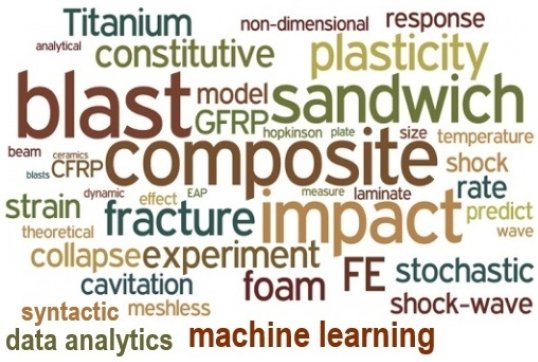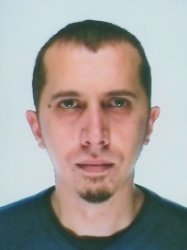Research Expertise

Word cloud of keywords from my publications, summarizing my research interests and expertise.
Sponsors

Current and previous sponsors include

Research projects

The loading of structures in deflagration events
Theoretical and numerical modelling (including CFD and FE) as well as laboratory-scale experiments are performed to assess the loading histories exerted on engineering components exposed to deflagration. The dynamic elasto-plastic response of different types of structures is analysed with the objective of providing design guides to the oil & gas industry. We analyse in detail fluid-structure interaction, pressure clearing, and shielding in congested geometries.The aim of the project is to aid certification of existing designs against deflagration and blast, as well as optimisation of new designs; we write authoritative guidance documents to this effect (with Hannes Gauch, Dr Francesco Montomoli, as well as Drs S.Rossin and V.Bisio of BHGE).
Electro-mechanical response of CNT-polymer composites
 Multi-scale FE simulations are conducted on volume elements representative of the microstructure of polymers reinforced by carbon nanotubes, with the aim of predicting elastic response, electrical and thermal conductivity, as well as the sensitivity of conductivity to imposed mechanical loading. Stochastic volume elements of the material's microstructure are analysed at different length-scales and numerical predictions are compared to theoretical models as well as electro-mechanical measurements. Machine learning exercises are conducted to enable multiscale simulation of realistic CNT composites (with Miguel Matos, Prof Silvestre Pinho, Dr Pedro Baiz-Villafranca).
Multi-scale FE simulations are conducted on volume elements representative of the microstructure of polymers reinforced by carbon nanotubes, with the aim of predicting elastic response, electrical and thermal conductivity, as well as the sensitivity of conductivity to imposed mechanical loading. Stochastic volume elements of the material's microstructure are analysed at different length-scales and numerical predictions are compared to theoretical models as well as electro-mechanical measurements. Machine learning exercises are conducted to enable multiscale simulation of realistic CNT composites (with Miguel Matos, Prof Silvestre Pinho, Dr Pedro Baiz-Villafranca).
Applications of machine learning, data analytics and information theory to the mechanics of solids Can we observe a deforming material microstructure during an experiment and automatically deduce, with the help of force measurements, the constitutive response of the solid? Can such response be automatically coded for direct use in FE simulations? Is it possible to conduct concurrent multi-scale simulations of deformation and fracture of solids at a computational cost 10 orders of magnitude smaller than it is possible today, by teaching a machine the constitutive behaviour of the material's constituents at multiple lenght-scales? We try to address these exciting questions by applications of machine learning, data analytics, information theory and spatial descriptive geometry, as well as new experimental techniques for the characterisation of damage in solids (with Weijian Ge, Miguel Matos, Yichi Song and Dr Mehtab Pathan).
Can we observe a deforming material microstructure during an experiment and automatically deduce, with the help of force measurements, the constitutive response of the solid? Can such response be automatically coded for direct use in FE simulations? Is it possible to conduct concurrent multi-scale simulations of deformation and fracture of solids at a computational cost 10 orders of magnitude smaller than it is possible today, by teaching a machine the constitutive behaviour of the material's constituents at multiple lenght-scales? We try to address these exciting questions by applications of machine learning, data analytics, information theory and spatial descriptive geometry, as well as new experimental techniques for the characterisation of damage in solids (with Weijian Ge, Miguel Matos, Yichi Song and Dr Mehtab Pathan).
Modelling of the role of heterogeneity in the response of materials
Physically-based constitutive models are constructed; these account for the spatial variation of mechanical properties in the microstructures of different solid materials of engineering interest, and predict the effect of such variation upon the global mechanical response. Different classes of materials are examined, including polycristalline metals, sintered metal powders and Titanium foams. Stochastic theoretical models of the fracture response of heterogeneous solids are developed (with Yichi Song, Panagiotis Zacharopoulos and Prof Andreas Schiffer).
High-strain rate testing of high-performance engineering solids and fibres
 The project addresses the current difficulties with measurements of the high strain rate response of high-performance engineering materials, including fibre systems for composite applications and technical ceramics. New probes are constructed to allow direct measurements of the mechanical properties of high-performance fibre systems across wide ranges of applied strain rates, temperatures, specimen volume and environmental conditions (with Junyi Zhou, and Profs Paul Curtis and Phil Duke of [dstl]).
The project addresses the current difficulties with measurements of the high strain rate response of high-performance engineering materials, including fibre systems for composite applications and technical ceramics. New probes are constructed to allow direct measurements of the mechanical properties of high-performance fibre systems across wide ranges of applied strain rates, temperatures, specimen volume and environmental conditions (with Junyi Zhou, and Profs Paul Curtis and Phil Duke of [dstl]).
Viscous damping in composite laminates
Multi-scale numerical models are constructed to predict the viscoelastic response of multidirectional composite laminates subject to arbitrary mechanical loads at different frequencies and temperatures; the models are used to derive designs of real composite components with optimal stiffness and damping. Numerical predictions are compared to experiments and inspire the formulation of new predictive theoretical models. We also develop optimization methods, based on genetic algorithms, for the optimal design of composite laminates with viscoelastic inserts (with Dr Mehtab Pathan and Dr Sophoclis Patsias of Rolls-Royce plc).
Stochastic modelling of the size-dependent inter-laminar strength of composite laminates
Multi-scale, physically-based models for the initiation and propagation of cracks in heterogeneous solids, such as fibre composites, are developed. The models are informed by quantitative observation of the material microstructure and by repeated mechanical tests; they predict the material strength including its scatter and size dependence, in both static and dynamic loading scenarios (with Yichi Song and Prof John Morton).
Fluid-structure interaction in deep-water blast
We aim at developing an understanding of the dynamic response of different types of submerged structures to underwater blast, as well as investigating the effect of exposure to water upon the mechanical properties of composites employed in submerged constructions. We pursue this by conducting scaled-down laboratory blast experiments and developing novel theoretical and numerical models, as well as conducting extensive mechanical testing on advanced composites materials (with Dr Gustavo Quispe Quino, Prof Andreas Schiffer and Prof Nik Petrinic).
Notes:
- This list is not comprehensive and is updated approximately once a year
- Check our YouTube Channel!
WORK/STUDY/PLAY WITH US

- PhD, post-doctoral and other research positions are advertised in jobs.ac.uk, iMechanica and Aeronautics website.
- UROP opportunities are available at any time for Imperial College Students.
- Prospective self-funded PhD students are invited to check admission requirements in the Imperial website, and to send an informal inquiry via email prior to submitting an online application.
- NOTE: The department of Aeronautics does not offer internships to students from other universities unless exchange programmes with Imperial College are already in place.


